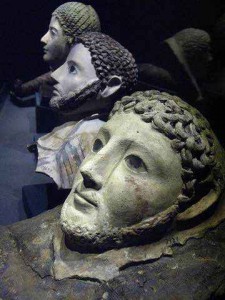As it is that night of the year, I figured now was the time to have a bit of fun and talk about ghosts.
This is actually a long-time favorite subject area for me, as I was fascinated by ghosts, the supernatural and anomalous activity and para-science in general throughout childhood – largely because of a book I had a kid, which I utterly devoured over and over again; but also on account of a few anomalous experiences I had, which naturally rendered me partial towards the subject.
The book, by the way, was called The Supernatural and was written by the late, towering intellect that was Colin Wilson.
Though I’ve read lots of other books on these subjects, none have ever compelled me as much as Wilson’s. It helps that Wilson was such a great intellect and big thinker and wasn’t at all credulous or gullible: and so there was probably no one better to collate and try to draw understanding from several centuries of scientific, esoteric inquest, detailed investigations and vast amounts of recorded testimony, including the work of some of the greatest thinkers of the previous few centuries, while at the same time weeding out the charlatans, fakers and hoaxes.
There are still lots of charlatans, fakes and hoaxes today too – in fact, far more so than in the previous centuries. And about 90% of stories and claims are probably fake or opportunist: but what’s important is that the remaining 10% or so warrant serious consideration, and might hold vital information about the nature of reality and our existence if examined diligently.
All of that aside, the actual subject of this post is a specific area of ghost lore that Wilson actually didn’t really cover in his wonderful book, and that allows me to combine two of my favorite subjects: anomalous activity and ancient history, particularly the Roman world.
Specifically, ancient ghosts – or more accurately, ghosts in the ancient world. People often mistakenly think that the typical or familiar ghost stories are a fairly modern phenomenon or something dating from roughly the Victorian era. But most of what we think of as the archetypal elements of typical ghost stories in fact go far back into the ancient world.
This actually makes perfect sense, as in most ancient cultures, and in fact in most pre-industrial societies, superstition, along with belief in the supernatural – and in ghosts or spirits – were a part of every day life. Almost all cultures believed in an afterlife and in human survival beyond bodily death.
In ancient Babylon, it was believed that ghosts roamed the night while the living owned the daylight hours.
In Assyrian households, it was believed that anyone who hadn’t been honored with a proper burial would return to haunt the living as a ghost – and this, interestingly, is a theme that has recurred in multiple cultures and through virtually every era.
The dead were also believed to suck the life force from the living, leading the Assyrians to create complicated rituals to protect living people from being plagued by spirits.

The Egyptians were particularly obsessed with the afterlife; an obsession that permeated their burial customs, art and mythology. It is therefore no surprise that many, even more modern, superstitions and supernatural mythologies have been retroactively attributed to Egypt and Egyptology, such as the famous ‘Curse of Tutankhamen’ that is claimed to have plagued those involved in the excavation of the Boy Pharaoh’s burial chamber.
In 1915, Egyptologist Gaston Maspero published a partial translation of what can be described as an ancient Egyptian ghost story, pieced together from pieces of pottery. In the story, the ghost of a mummified man speaks to a high priest of Amun, telling him about his post-death conditions. “I did not see the rays of the sun. I did not breathe the air, but darkness was before me every day, and no one came to find me,” the spirit explains. Maspero wrote that the troubled spirit seemed to be complaining about something that had happened to either himself or his tomb, but the Egyptologist was unable to determine what precisely the cause of his ordeal was supposed to have been.
Christianity of course could be regarded as being centered on a ghost story – though I’m sure most self-respecting Christians would object to me describing Jesus as having ‘haunted’ his disciples as a ghost. Islam doesn’t seem to have talked about ghosts, but about non-human spiritual entities called ‘djinn’.
In some older Scandinavian cultures, it was believed by some that the Aurora Borealis or Northern Lights were the spirits of stillborn babies.
As for the Romans – who we’re mostly focusing on here – they were a deeply superstitious society at every level. In their daily lives they not only communicated and interacted with their gods via offerings, rituals and supplications, but also observed a form of ancestor worship.
The Roman nobility are known to have displayed ancestral images – funeral masks or busts – in their homes, the masks being molded from wax from the face of the deceased and these objects being understood to palpably maintain a link between the spirits of the dead and the lives of the living.

Some tend to ask why ‘Roman Ghosts’ or ancient ghosts seem to never feature in modern ghost stories or modern urban myths; whereas there tends to be a preponderance of Victorian-era ghosts claimed to have been seen, for example, in Britain, or Civil War era apparitions reported in the United States.
Actually, this perceived absence of Roman apparitions isn’t strictly true – for one thing, there is the particularly fascinating phenomenon of the Roman ‘Ghost Armies’ or Legions in Britain, the stories of which go back quite a long time.
However, there are – even aside from the famous ghostly ‘legions’ – some ghost-related traditions involving the Roman era.
The famous Roman senator Pliny the Younger, who lived until 113 AD, recounted a ghost story that survived for thousands of years; and bears some resemblances to some of the more ‘typical’ ghost-story ingredients of more modern tales.
Addressed as a letter to his friend, Licinius Sura, he wrote, “There was at Athens a large and roomy house, which had a bad name, so that no one could live there. In the dead of the night, a noise — resembling the clashing of iron — was frequently heard, which, if you listened more attentively, sounded like the rattling of chains,” he wrote, describing a haunting not dissimilar to Dickens’ classic Jacob Marley.
The disturbances in the home culminate in the emergence of a spectral “form of an old man, of extremely emaciated and squalid appearance, with a long beard and disheveled, hair, rattling the chains on his feet and hands.”
When a philosopher named Athenodorus heard the ghostly story, he is said to have rented the house in order to encounter the ghost. The ghost appeared and rattled around before vanishing. The story goes that Athenodorus marked the spot where the ghost vanished and, the next day, instructed for that spot be dug up. “This was accordingly done,” Pliny explains, “and the skeleton of a man in chains was found there, for the body, having lain a considerable time in the ground was putrefied and moldered away from the (chains).”
After being given a respectful burial, the ghost was seen no more and the house was never disturbed again.
Here, in this 1st century tale from Pliny, is virtually a blueprint for many of the haunting stories that cropped up hundreds of years later, increasing in the Victorian era and proliferating through the early 20th century, forming what has now for some time been one of the archetypal stories in ghost lore. So many of these later or more modern stories involve alleged disturbances or hauntings where excavation later reveals improperly buried remains – and once the remains are dealt with properly, the disturbances reportedly cease.
It is entirely unclear, however, whether that indicates the presence of a real ‘spirit’ or ghost, or whether the unconscious or subconscious mind of the experiencer has somehow ‘detected’ the presence of improperly buried remains in the property and has played out what is essentially a hallucination as a way of prompting action.
Wilson’s aforementioned book The Supernatural is full of cases – from different eras and cultures, including the 20th century – that match this template precisely; suggesting either that this is an archetype that exists in our collective consciousness (or Collective Unconscious, according to Carl Jung) or that the same basic story has been passed down from generation to generation and culture to culture, albeit with a few alterations here and there.
_______________
Of the 53 Emperors of the Western Empire, the only one with a famous ghost legend was the mad Emperor Nero.
Which in some ways is surprising, as the Romans were highly superstitious people and the Emperors, particularly in the Julio-Claudian line, were considered divine, which, you would think, would lead naturally to lots of ghost stories and myths.
You would expect there, for example, to be all kinds of stories about the ghosts of Augustus or Claudius or Tiberius – although, given how much Roman literature is lost to us (however many Roman texts we think we have access to, we actually only possess a tiny fraction of the Roman literature that once existed), maybe all the supernatural stuff was contained in lost works.
Nero, who was murdered in 68 BC, has supposedly been seen on the Via Nomentana, where he met his death. He was also seen to haunt the Piazza del Popolo, where was where his tomb used to be.

The myth was that a ‘cursed tree’ grew up from his grave, which was haunted by black crows and where Nero’s ghost was believed to linger alongside witches and demons. In 1099, apparently after people had been frightened enough, Pope Pasquale II had the tree burnt down and a chapel built in its place, while Nero’s tomb was dug up and thrown into the Tiber.
This story, we might suspect, wasn’t true.
For one thing, the stories of ghostly disturbances appear to have been going on almost a thousand years after Nero’s lifetime and don’t appear to originate in the century of Nero’s death. For another, the Pope desecrating the tomb (which, today, would qualify as a crime against world heritage) and building a chapel on it suggests the entire story might’ve been a piece of early Christian propaganda to symbolize the ills of the old Roman pagan era and the virtues of the new Christian era.
The most famous ghost mythology concerning a known historic Roman character – and not just a random figure – would be that of Messalina, the scandalous wife of the Emperor Claudius.
Messalina, who we are told lived a debauched, promiscuous lifestyle behind the back of her husband, was eventually put to death. The accounts of her death are pretty grim, even by Roman standards; she was given a dagger and instructed to kill herself in front of dutiful Roman soldiers.
But though she tried to fatally cut herself, she struggled to do it effectively – in the end, a soldier put the necessary muscle into it and she died. The scene is very powerfully depicted – albeit with some artistic license – in the I Claudius TV drama, as well as in various artworks and literature through the ages.

The legend has continued all the way to the modern day that her ghost still walks around the area of the Colle Oppio – which is very similar to the stories of Anne Boleyn’s headless ghost in England; which raises the question of whether we perhaps have a cross-cultural archetype of (or fascination with) the ‘wronged’ or vengeful woman being unable to find rest due to end-of-life trauma.
However, Anne Boleyn’s ghost isn’t reported to pinch men’s arses – which Messalina’s ghost is claimed to do. Which is just as well – as the idea of a headless Anne Boleyn pinching people’s bottoms is just a little too much.
The stories about the ghost of Messalina are almost certainly not true anyway, just old wives’ tales.
There was also Julia Berenice (early 1st Century AD), who was the daughter of King Herod Agrippa I (and grandmother of the Salome who appears in the Gospel stories) and mistress of the Emperor Titus: a ghostly tradition is associated with her too.
There are, it appears, common reports of minor paranormal phenomena at the Coliseum; mostly people reporting ‘cold spots’, otherworldly whispers and the like. Workers in the Coliseum have supposedly reported hearing uncommon noises and both human and animal screams. There have been some claims of a ghost – apparently of Julius Caesar – being seen in the Coliseum by visitors; but, assuming there was any ‘ghost’ at all, it is unlikely to have been Caesar’s, as the Coliseum wasn’t built until decades after Caesar’s lifetime and he would’ve had no connection to that space.
This suggests people are simply seeing what they, on some level, expect to see – even if that preconception doesn’t fit the historic facts.
It is also likely that the evocative atmosphere of the Coliseum simply triggers a psychosomatic effect, leading people to think they’re experiencing echoes from the distant past. On the other hand, various parapsychologists would’ve suggested that locations where powerful, emotional or traumatic events occurred – especially over an extended period of time, such as in the Coliseum – might ‘record’ strong impressions that in turn are picked up on by particularly sensitive people for reasons we don’t fully understand yet.
On a more serious note here, this would be a variation on what I think is one of the most fascinating and under-explored ideas from early twentieth century speculative science – what is called ‘Stone Tape Theory’.
‘Stone Tape Theory’ forwards the idea that electrical/mental ‘impressions’ released – particularly during a traumatic event – are somehow ‘stored’ in moist rocks and other particular conditions.
This idea was originally conceived by Thomas Charles Lethbridge, a British archaeologist and parapsychologist, in 1961, though a similar theory was forwarded by philosopher H.H Price in the 1940s – both of which I first read about in the aforementioned Colin Wilson book I read as a child. The Coliseum would, in theory, be a massive example of such a location, given its long, bloody, traumatic history and the presence of so much ancient stone.
Or, like I said, just psychosomatic. Whatever you prefer.
Aside from Pliny’s tale, mentioned earlier, the famous 1st century historian Plutarch (45 to 120 AD), told the story of how, in the city of Chaeronea in Greece, there was a boy named Damon who drew the affections of a Roman commander, who is said to have fallen in love with him.
The boy rejected the commander’s advances. Knowing that the offended commander would respond harshly, the boy was said to have gathered a gang of friends and attacked the Roman, killing him (along with several other Roman personnel). Chaeronea’s city council condemned him and his accomplices to death. The story has it that the Damon then had the council killed before his own death sentence could be carried out, then fled with his friends into the Greek countryside.
Knowing that he would be killed if he did nothing, Damon got a group of friends together, ambushed the Roman commander (and several other Roman soldiers), killing them. The city council of Chaeronea condemned Damon and his friends to death. After that proclamation, Damon, who had not been killed, had the council members killed. Some time later, ‘Damon’ returned to the town, but was later killed in the bath house. Later it was reported that ghostly incidents occurred in the place. Plutarch wrote, “certain phantoms appeared in the place, and groans were heard there,” reporting that “the door of the vapour-bath was walled up, and to this present time, the neighbors think it the source of alarming sights and sounds.”
Both Plutarch, and the aforementioned Pliny, were both highly intelligent, erudite figures and don’t necessarily present their respective ghost stories as fact, rather as simply tales passed on via word-of-mouth. Even highly educated Romans, however, were probably still superstitious though, as it was simply embedded in the culture, along with belief in an afterlife – so it is also entirely possible they both fully believed these stories.
Here’s one more.
Among other supernatural stories from the Roman world, there was at least one that reads like it was written many centuries later by the Brothers Grimm. Professor Debbie Felton, who studies folklore concerning the supernatural, is the author of Haunted Greece and Rome: Ghost Stories from Classical Antiquity, which examines some of the stories of ghosts and hauntings from ancient eras.
One of her oddest stories from Roman times concerns, not a ghost, but apparently either a werewolf or a shapeshifter.
The story is told by the Roman writer Petronius in ‘Satyricon’, in which a man leaves Rome and is headed to a country villa to meet his mistress and a soldier offers to accompany him on the journey. Pausing to rest by a cemetery outside the city, the soldier takes off his clothes and turns into a wolf. Terrified, the man runs for some time towards the location of the villa, but finds that the flocks there have been ravaged by a wolf. But, the story goes, one of the servants fought and managed to wound the wolf.
When the man goes back to Rome, he later encounters the soldier again and finds him being treated by a doctor for his wound. If that story were being told today, it would certainly be regarded an urban myth – which is probably what it was.
Or, you know, it was a werewolf. Whatever you like. But it’s probably the most suitable of the Roman horror stories for Halloween purposes.





Very interesting… one more story for the record. There’s a laddy I mentor and he worrks with a somewhat verbally abusive building crew. This last week he had to do some work under and vintage California dwelling in the old gold rush country and one of the older bloaks was trying to spook him with the thought of ghost hauntings in the old house. The lad said he later asked his oppressive boss for the day if he himself believed in ghosts and said the response was a tacit “hell no”, but that he then went on to tell a fascinating story of something strange that occured to him ashe drove home on a dark and foggy stretch of a windy mountain road.
He narrated that he slowed down as he faintly saw what appeared to be a horse drawn carraige crossing the road and that as he got closer and stopped he saw that it was loaded with people but noted that their faces were not visble. He had been drinking that night and pawned off the incident without telling anyone about it.
He also said that there was some road widening work underway at that section of that road which he regularly drove and mentioned that it had been reported by the crew that was felling the trees there was a certained tree that they struggled to cut down because it kept breaking the chains on their chainsaws. The story gcontinues that they eventually resorted to axes and that during the chopping an ax hit something metal deeply embedded in the old tree… as the work progressed a old hitching post was uncoverered that had been nailed to the tree that was at the same location where he saw the ghostly wagon.
Thanks for that story; that’s really interesting. His story of the carriage brings very much to mind the British stories of Roman legions being seen in certain areas – and I really favor the theory that suggests that these apparitions are somehow ‘recordings’ of the past embedded into the living environment.
I just came back from celebrating Halloween in Ireland, and took a “ghost haunting tour”, which was very interesting. I learned about some very interesting figures based in Kilkenny, and learned that some of the stories were concocted to hide REAL crimes, and that some of these people got away with it as a result. It triggered feelings of anger and fascination, because I think of the people who never got justice as a result of the ruse. But I guess that’s actually a common phenomenon throughout human history.
But no ghostly phenomena? Although, you don’t seem like someone who’d get scared anyway.
There’s also some interesting ‘fairy’ folklore and legends in Ireland too.
They talked about some ghostly phenomena, but I was mostly interested in the story of Dame Alice de Kytler and her servant Petronella de Meath. That was a story where as always, it was the “help” that took it the worst, even if they were not the truly responsible ones. I don’t think Dame Alice was really a witch, but from what I heard, she probably killed all her husbands and was far too greedy for her own good. She was also a moneylender, with the entire town of Killkenny owing her money (which explains why they hated her guts). King Phillip of France burned the Knights Templar (he didn’t want to pay back what he owed), so the townspeople wanting to burn Dame Alice to “conveniently” erase their debts was understandable (though burning people at the stake is still wrong, of course). But it wasn’t the townspeople who got the ball rolling on the witchcraft accusations, they were just bandwagoners. The ones who got it started were Dame Alice’s stepkids from her 4th husband.
You may already know about Dame Alice, but I’m going to write as if you don’t. For further reference, she has her own Wiki entry and her old inn is still in business to this day. She had one son from her first husband, who became her “right hand man”. She remarried, and each time the husband died and left her EVERYTHING. She was already wealthy before the dead husbands, but of course their deaths only enriched her more. She finally went overboard when the final husband, who was clearly poisoned, rewrote his will leaving EVERYTHING to Alice and her son, and cutting out his biological children from his will. Of course, if you were one of his kids, you would be seriously pissed and think that Alice must have done some hexing to get this to happen. Even worse, she was already filthy rich with or without this final husbands fortunes, yet she and her son insisted on hogging everything and taking the rightful share of his children…yeah, if I was one of her husband’s kids I would LOVE to burn her at the stake too. I’m not saying it’s right, but the feeling is definitely understandable.
In the end, she escaped getting burned at the stake. Instead, the girls she hired to run her inn and her head servant, Petronella, were the ones who were punished severely (what an understatement). The tour guide said that Petronella’s ghost still haunts the place where she was burned, and said that if you had the “gift” you could feel the presence of her ghost. Clearly, I don’t have the gift.
To clarify, even as an atheist, I do believe in energy fields and vibrations, and they do affect us in many ways we have yet to understand. My hunch is that I am naturally insensitive and unintuitive, which is why I don’t feel vibrations as well as others. I don’t fear ghosts, but not for the reasons you think. When I hear the real story of the alleged ghost, my first reaction is really sadness, then anger. Also, I tend to run an imaginary dialogue in my head:
“Why would you waste your time and energy scaring me when you could go after the people (and their descendants) who were responsible for what happened to you? How can you have the power to affect me but not them? Where are your priorities? I mean really!”
So maybe, just maybe, I convince them with the sheer power of my emotional logic to leave me alone (LOL). All kidding aside, I’m right you know. If they want to put their haunting skills to good use, the least they can do is use it on the people who REALLY deserve it. 😉
Yeah, I get that. I would love Dick Cheney and Don Rumsfeld, for example, to be permanently haunted by a few thousand ghosts of Iraqi kids.
No, I didn’t know the Dame Alice story – that’s a really interesting one. I’ve read a lot of books, however, on the witchcraft hysteria from previous centuries – particularly in England and Germany, though also much later in the US. It’s a really fascinating subject, relating to the phenomenon of mass hysteria, scapegoating and demonisation – not to mention the extraordinary levels of cruelty and sadism. The same basic phenomenon still goes on in our modern, even Western, societies – minus the torture and burnings for the most part, but still with the underlying psychology of mass/collective demonisation of certain groups of people who are portrayed as a ‘threat’ to traditional values or the traditional community, etc. If people could get away with chasing down ‘witches’ or whoever else with pitchforks and torches today, they’d still be doing it.
What an intriguing romp through the, who-knows other world/s? Keep my ops open but have to err on, we’re not all so inhabited by the departed? There’s a ghostish incident or two in the Bible – where my eyes are wide open towards – and coming to mind, a verse that talks of us, ‘being surrounded by a cloud witnesses’. Don’t let that get too inside me in a certain way, have enough fantasy crowds subconsciously going on and all so-many people reading my online blurb – when… don’t think so/stats-say …nah.
‘As for the Romans’ one dig of a note and addition on Nero. (‘Dig-bit’ is the challenge this should cause Biblicists gettin’ all shook up and detailed about reckoned specific Anti-Christ. All written ahead/back then/about today… ok, tomorrow-ish – disputing each other, yet, oh ye confidently say so).
Or, makes sense; Book of Revelation writer (most likely ‘John’) is primarily reflecting on 666, so-feared and revered, having indestructible powers – Nero. That this dominant figure, wouldn’t finally die/gone but rise again. This seemed to have gripped all back then. His monster activities and the up and coming destruction, God sees and warns about. (The alt. is Rev. written much later/not my understanding). So yes, dead-around times abounded. Nuff from me sidetracking into theology and the Revelation OF Jesus Christ (vs1) – dig x2. A get me looking more into article. Best compliment – has me reading around and following signposts. Condensed and readably brief and for more of these open but grounded investigations. Not sure about getting the torch out and early hours stuff but words-wise. Be good.
Wherefore seeing we also are compassed about with so great a cloud of witnesses, let us lay aside every weight, and the sin which does so easily beset us, and let us run with patience the race that is set before us,
Hebrews 12:1
Mark, I think what that verse is saying is because there are so many people or ‘cloud of witnesses,’ all thinking their individual thoughts and beliefs are ‘The Way” in the final analysis, it is between the individual and God, irregardless of what others say or do.
No one can be saved by Christ living in someone else, but only with Christ living inside you. On that score I agree with the Pope who said “inside every Christian lives a Jew.”
I can’t speak for other believers, but the object of my Faith is the constant, life long struggle to overcome the pettiness, greed, hatred, selfish self-centred ways of this material world, the traditions and habits that preventing us from grasping the whole Dimension of Spirit. No one else can do that for me.
John the Revelator is explicit in what is involved:
These things say the Amen, the Faithful and True Witness, the Beginning of the Creation of God;
I know your works, that you are neither cold nor hot: I would you were cold or hot.
So then because you are lukewarm, (silent majority?) and neither cold nor hot, I will spew youout of my mouth.
Because you say, I am rich, and increased with goods, and have need of nothing; and know not that you are wretched, and miserable, and poor, and blind, and naked:
I counsel you to buy of me gold tried in the fire, that you may be rich; and white raiment, that you may be clothed, and that the shame of your nakedness do not appear; and anoint your eyes with eye salve, that you may see.
As many as I love, I rebuke and chasten: be zealous therefore, and repent.
Behold, I stand at the door, and knock: if any man hear my voice, and open the door, I will come in to him, and will sup with him, and he with me.
To him that OVERCOMES will I grant to SIT WITH ME in my throne, even as I ALSO OVERCAME, and AM set down with my Father in his throne.
He that has an ear, let him hear what the Spirit says to the churches.
Revelation 3
This is real power sharing, becoming a co-Creator with God while we are still in the flesh, before we become ONE with God Eternally after we give up the corruptible flesh.
Odd one that cloud verse. Could mean… who knows? Definitely implies is about the departed/here though. ‘In us a ‘Jew”… Mmmm? If ‘you’ like. Has some value but – much caution for me. Hey, better watch myself, sent a tweet the other day; ‘Why debate Christians period? Most imp. now-fight is for Biblicists’ freedom to publicly proclaim and – not have to bake every msg on a cake’ – hear the hypocrite alarm. Did look at your site this morning, certainly unusually interesting. Respect. Moving on, since you kindly replied: we can differ all we like and agree when we… do – but utterly not-much seeing, Jesus lover ones, doing like I see fit (in trying to) does, despair me. As happs, just before this comment/here, put a v.rare one on a v.good Christian fellows’ site. A more-rare one, I read. ‘No Trump Card: Partisan Politics, Divine Providence, and What the Cross Reveals About Power as Control’ is the post. One to bless you with/maybe. Appreciate the obviously not-so typical output from you, whilst something to learn. Will read you and gain some. Be well. Thanks.
Other post hasn’t made the search engines as yet, it’s this: https://uncontrollinglove.com/2016/11/01/no-trump-card-partisan-politics-divine-providence-and-what-the-cross-reveals-about-power-as-control/
Thanks for that enlightening response Ray – your dedication is notnunnoticed… I do beg to differ as the white horseman in the 4 horsemen of revelation and the return of Christ on a white horse are very well representing the same horse and rider with the exception that the former white horseman (1 of 4 differently colored horses) are the people of yore of Christ (Christendom) who as nations went forth to conquer the earth and deliver nations.
English and Spanish are the most widely spoken languages on the planet because there are vestiges of those campaigns; and in their heyday both nations enjoyed colonial empires where “the sun never set”.
Prior to their conquerings both nation demonstrated a formidable struggled to keep their respectively individual brand of Christianity: Spain (of whom Paul spoke) cast off the yoke of Islam and embraced the cross and everywhere it went to conquer it planted the worldly empire for the king or queen while the Franciscans planted the cross and established missions for the Universal Church (to which I do not particularly suscribe but do recognize its achievements).
About 100 years after Columbus sailed, England, through the likes of Tyndale (like Germany under Luther) also went through it’s own spiritual revolution as it reformed it’s church and separated from the Universal Catholic Church by translating the Bible into the common vernacular and the resulting King James Authorised Version (AV) 1611 came shortly after William Tyndale yelled: God, open the eyes of the King of England! – as he was burning on the stake.
England’s love for the scriptures made her the most prominent Bible reading nation of that time and her understanding of the scriptures combined with her seamanship hugely contributed to her being one of 2 great witnesses and conquerors for Christ throughout the Earth.
Other countries also conquered and “evangelised” during that period, but none of that era on a comparable scale as England and Spain whose campaigns and victories are basically a macrocosm of what Joshua just as importantly had achieved on a smaller scale in the land of Canaan.
It is noteworthy that nearly half a millenium later both of the deminished empires enjoy trade with their respective excolonies, but spiritually speaking it is Spain that has left more visible “fruit that remaineth” unto the kingly Christ that is to soon return on a white horse.
Thanks Mark. Yes, my understanding/interpretation of the Book of Revelations has always been that the Anti-Christ figure was a reference to Nero and that everything in the book was talking about events in that century – and not prophecies of things to come thousands of years later.
In my opinion, Revelations would’ve been better not ever being included in the New Testament – as it has caused so much trouble over the centuries, right to the present day.
I guess you didn’t take note the Alt-Christian-Republican right have been calling Obama the anti-Christ since he was President so it’s still current.
Revelation is surely enigmatic… it amazingly parallels chapters of the OT book of Daniel, and the four horsemen can be to some extent interpreted as the white horse being the Brits and Spaniards conquest of the earth, the red as the era of Colonial and World Wars, the black as the industial ages upto the present geo economy – a loaf of barley bread for a days wages (scarcity and poverty of for the labors [while grain is used to make fuel]) do not touch the oil (petroleum) and the wine (ethanol); and the grisled, pale, or as William Tyndale (my earthly hero) translated it, green horse, is the eevastation to come in a nuclear event. The description and fall of Babylon can also fit 911 as the merchants of the sea bewailed to smoke of the torment of the city that traded with the whole earth (chapters 13 & 18).
Interestingly ancient Babylon is the site of the tower of babel where the great confusion of tongues stemmed from 911 too the woman straight there and we all know the rest of the story up until the present chaos.
Our personal experiences shape our personal perspectives and attitudes.
American Christians don’t see where the US fits in the Bible, but I wrote about the US and Revelation 5 years ago.
“And I saw heaven opened, and behold a white horse; and he that sat upon him was called Faithful and True, and in righteousness he does judge and make war.
Revelation 19/11
In 1981, I was receiving Spiritual impulses to hitch hike from Ottawa to Whitehorse in the Yukon to draw attention, symbolically, to the rider on that white horse. This was an ambitious 5000 mile round trip journey. Newspapers across CanaDa, including The Whitehorse Star chronicled this Mission of Faith.”
THE REVELATION OF JESUS CHRIST: From 19/11 to 9/11
August 28, 2011
https://ray032.com/2011/08/28/the-revelation-of-jesus-christ-from-1911-to-911/
Thanks for all your effort in putting this interesting information together.
Three years ago I read a Halloween article I re-posted to my Blog with my additional perspectives.
‘DEATH & RESURRECTION’
October 31, 2013
https://ray032.com/2013/10/31/death-resurrection/
Thanks, Ray – will read it asap.